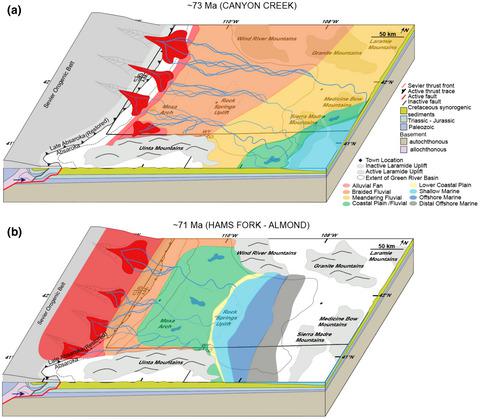当前位置:
X-MOL 学术
›
Basin Res.
›
论文详情
Our official English website, www.x-mol.net, welcomes your
feedback! (Note: you will need to create a separate account there.)
Effects of contemporaneous orogenesis on sedimentation in the Late Cretaceous Western Interior Basin, northern Utah and southwestern Wyoming
Basin Research ( IF 2.8 ) Pub Date : 2021-10-26 , DOI: 10.1111/bre.12623 Elizabeth M. Davis 1 , Kurt W. Rudolph 1 , Joel E. Saylor 2 , Thomas J. Lapen 1 , Julia S. Wellner 1
Basin Research ( IF 2.8 ) Pub Date : 2021-10-26 , DOI: 10.1111/bre.12623 Elizabeth M. Davis 1 , Kurt W. Rudolph 1 , Joel E. Saylor 2 , Thomas J. Lapen 1 , Julia S. Wellner 1
Affiliation

|
Three drivers of subsidence are recognized in the Western Interior Basin: Mesozoic–early Cenozoic flexure adjacent to the thin-skinned, eastward propagating Sevier Orogeny, Late Cretaceous–Eocene flexure associated with thick-skinned Laramide Uplifts and Late Cretaceous dynamic subsidence. This study combines outcrop lithofacies, palaeocurrent measurements, detrital zircon geochronology, biostratigraphy, stratigraphic correlations and isopach maps of Coniacian–Maastrichtian (89–66 Ma) units to identify these subsidence mechanisms impact on basin geometry and stratigraphic architecture in the northern Utah to southwestern Wyoming segment of the North American Cordillera. Detrital zircon maximum depositional ages and biostratigraphy support that the Maastrichtian Hams Fork Conglomerate was deposited above the Moxa unconformity in the wedgetop and foredeep depozones. The Moxa unconformity underlies the progradational Ericson Formation in the distal foredeep. The Hams Fork, however, is younger than the Ericson Formation, and instead equivalent to upper Almond Formation. Therefore, the hiatus associated with the Moxa unconformity continued for several million years longer in the fold belt and proximal basin than in the distal foredeep, with Ericson Formation-equivalent strata onlapping the Moxa unconformity towards the west. Regional thickness patterns record and constrain the timing of the transition from Sevier to Laramide-style tectonic regimes. From 88 to 83 Ma (upper Baxter Formation) a westward-thickening stratigraphic wedge characterized the foredeep developed by lithospheric flexure by thrust-belt loading. Nevertheless, the presence of >500 m of subsidence >200 km from the thrust front suggests a long-wavelength subsidence mechanism consistent with dynamic subsidence. By 83 Ma (Blair Formation) the long-wavelength depocentre shifted away from the thrust belt, with no evidence of a Sevier foredeep. This depocentre continued migrating eastward during the early-mid Campanian (ca. 81–77 Ma). The late Campanian–Maastrichtian (ca. 74–66 Ma) is marked by narrow sedimentary wedges adjacent to the Wind River, Granite and Uinta Mountain uplifts and attributed to flexural loading by Laramide deformation.
中文翻译:

同期造山运动对晚白垩世西部内陆盆地、犹他州北部和怀俄明州西南部沉积的影响
在西部内陆盆地,下沉的三个驱动因素被认为是:中生代 - 早新生代弯曲与薄皮向东传播的塞维尔造山运动相邻,晚白垩世 - 始新世与厚皮拉拉米隆隆起相关的弯曲和晚白垩世动态沉降。本研究结合露头岩相、古洋流测量、碎屑锆石年代学、生物地层学、地层相关性和 Coniacian-Maastrichtian (89-66 Ma) 单元的等厚图,以确定这些沉降机制对犹他州北部至怀俄明州西南部盆地几何形状和地层结构的影响北美山脉的一部分。碎屑锆石最大沉积年龄和生物地层学支持马斯特里赫特汉姆斯叉砾岩沉积在楔顶和前深沉积带的艾不整合之上。Moxa 不整合面是前深部前缘渐进的 Ericson 组的基础。然而,Hams Fork 比 Ericson 组更年轻,相当于上 Almond 组。因此,与 Moxa 不整合面相关的裂隙在褶皱带和近端盆地中比在前深部远端持续了数百万年,Ericson 组等效地层向西覆盖 Moxa 不整合面。区域厚度模式记录并限制了从 Sevier 向 Laramide 式构造状态转变的时间。从 88 到 83 Ma(上 Baxter 组),一个向西增厚的地层楔形特征描述了由逆冲带加载引起的岩石圈弯曲发育的前深层。然而,距逆冲锋 > 200 km 的 > 500 m 沉降表明存在与动态沉降相一致的长波长沉降机制。到 83 Ma(布莱尔地层),长波震中远离逆冲带,没有塞维尔前深的证据。在坎帕纪中早期(约 81-77 Ma),这个震源继续向东迁移。坎帕阶晚期-马斯特里赫阶(约 74-66 Ma)的特点是与风河、花岗岩和 Uinta 山隆起相邻的狭窄沉积楔形,并归因于拉拉米变形引起的弯曲载荷。
更新日期:2021-10-26
中文翻译:

同期造山运动对晚白垩世西部内陆盆地、犹他州北部和怀俄明州西南部沉积的影响
在西部内陆盆地,下沉的三个驱动因素被认为是:中生代 - 早新生代弯曲与薄皮向东传播的塞维尔造山运动相邻,晚白垩世 - 始新世与厚皮拉拉米隆隆起相关的弯曲和晚白垩世动态沉降。本研究结合露头岩相、古洋流测量、碎屑锆石年代学、生物地层学、地层相关性和 Coniacian-Maastrichtian (89-66 Ma) 单元的等厚图,以确定这些沉降机制对犹他州北部至怀俄明州西南部盆地几何形状和地层结构的影响北美山脉的一部分。碎屑锆石最大沉积年龄和生物地层学支持马斯特里赫特汉姆斯叉砾岩沉积在楔顶和前深沉积带的艾不整合之上。Moxa 不整合面是前深部前缘渐进的 Ericson 组的基础。然而,Hams Fork 比 Ericson 组更年轻,相当于上 Almond 组。因此,与 Moxa 不整合面相关的裂隙在褶皱带和近端盆地中比在前深部远端持续了数百万年,Ericson 组等效地层向西覆盖 Moxa 不整合面。区域厚度模式记录并限制了从 Sevier 向 Laramide 式构造状态转变的时间。从 88 到 83 Ma(上 Baxter 组),一个向西增厚的地层楔形特征描述了由逆冲带加载引起的岩石圈弯曲发育的前深层。然而,距逆冲锋 > 200 km 的 > 500 m 沉降表明存在与动态沉降相一致的长波长沉降机制。到 83 Ma(布莱尔地层),长波震中远离逆冲带,没有塞维尔前深的证据。在坎帕纪中早期(约 81-77 Ma),这个震源继续向东迁移。坎帕阶晚期-马斯特里赫阶(约 74-66 Ma)的特点是与风河、花岗岩和 Uinta 山隆起相邻的狭窄沉积楔形,并归因于拉拉米变形引起的弯曲载荷。











































 京公网安备 11010802027423号
京公网安备 11010802027423号